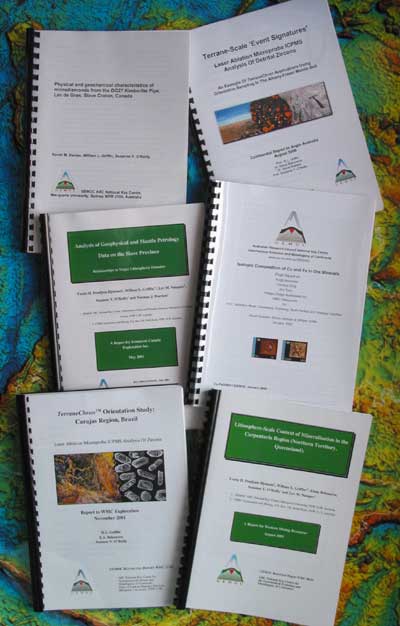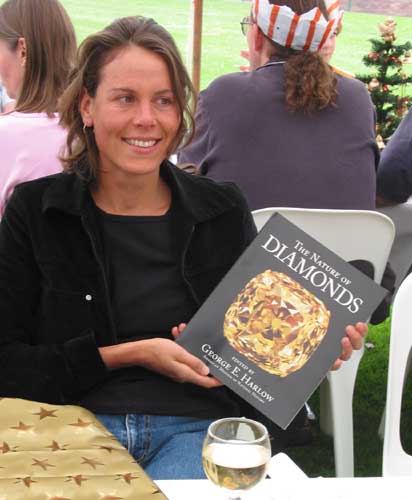Industry interaction
INDUSTRY INTERACTION, TECHNOLOGY TRANSFER AND COMMERCIALISATION PROGRAM
GEMOC RELIES on a vigorous interaction with the mineral exploration industry at both the research and the teaching/training levels. The research results of the Centre's work are transferred to the industry and to the scientific community by:
- interaction through collaborative industry-supported Honours, MSc and PhD projects
- short courses relevant to the industry and government sector users, designed to communicate and transfer new technologies, new techniques and new knowledge in the discipline areas covered by the Key Centre
- one-on-one research collaborations and shorter-term consultancies on industry problems involving national and international partners
- provision of high quality geochemical analyses and interpretations to industry and government organisations, extending our industry interface
- use of Macquarie Research Limited consultancies, which employ and disseminate the technological developments carried out by the Centre
- GLITTER, an on-line data-reduction program for Laser Ablation ICPMS analysis developed by GEMOC and CSIRO GEMOC participants, is available commercially through New Wave Research
- collaborative relationships with technology manufacturers (more detail in the section on Technology Development):
- GEMOC (Macquarie) is the Agilent Technologies ICPMS Australian demonstration site
- GEMOC (Macquarie) is the international Alpha test site for New Wave Research Lasers
GEMOC industry support includes:
- direct funding of research programs
- "in kind" funding including field support (Australia and overseas), access to proprietary databases, sample collections, digital datasets
- collaborative research programs (eg SPIRT (now Linkage Project), APA Industry and PhD program support)
- assistance in the implementation of GIS technology in postgraduate programs
- participation of industry colleagues as guest lecturers in senior courses (eg Bachelor of Technology)
- extended visits to Macquarie by industry personnel for interaction and research
 |
(clockwise from top) Simon Jackson, Suzy Elhlou, Norm Pearson, and Amanda Quadling from DeBeers, during Amanda's visit to analyse diamonds on the LAM-ICPMS |
PROGRESS IN 2001
The mineral exploration industry provided funding for two postgraduate student projects at Macquarie in 2001. In each case, the companies have provided invaluable in-kind support, and have been closely involved in shaping the research project.
A collaborative research project with Kennecott Canada Inc., funded by an ARC SPIRT grant, continued within the Lithosphere Mapping strand. Dr Yvette Poudjom Djomani completed a geophysical analysis of the Slave craton. Reports were prepared on xenolith petrology and diamond characteristics, and a study of Re-Os systematics of sulfide inclusions in olivine grains from the A154 kimberlite was completed (see Research Highlights).
10 Industry Reports were completed for collaborative and consulting projects.
An ARC SPIRT project (2001-2003) sponsored by WMC uses gravity data to interpret effective elastic thickness and integrates this with tectonic analysis and geochemical data across Australia. Planning and workshop sessions at Macquarie with participants from WMC and GEMOC, and a visit by Macquarie staff to WMC in Perth, were key activities. WMC also engaged GEMOC for a major TerraneChronTM project studying crustal evolution in South America.
DeBeers (Johannesburg), who provided contributory capital funding for the MC-ICPMS laboratory, continued a schedule of regular visits to Macquarie to participate in aspects of the development of LAM-ICPMS and MC-ICPMS techniques and applications. U-Pb dating of zircons by LAM-ICPMS and the trace-element analysis of diamonds were the focus of technology exchange with DeBeers in 2001.
The exploration consulting group GeoDiscovery is actively working with GEMOC to develop TerraneChronTM, a novel approach to terrane analysis (see Research Highlights). A GeoDiscovery/Macquarie collaborative project supported this project in 2000, and a Pasminco/GEMOC collaborative grant, brokered by GeoDiscovery, continued the program in 2001 (see summaries of current industry projects below). Dr Steve Walters visits Macquarie frequently to participate in this collaboration.
Many companies have provided high levels of in-kind support in the form of samples: these include access to diamonds and xenoliths through Rio Tinto and Kennecott Canada, suites of xenoliths from Ashton Mining of Canada and heavy mineral concentrates from numerous sources including BHP, DeBeers Australia and several small companies.
Numerous industry visitors spent varying periods at GEMOC in 2001 to discuss our research and technology development (see visitor list, Appendix 3).
DIATREEM continued to provide LAM-ICPMS analyses of garnets and chromites to the diamond-exploration industry on a routine basis, in cooperation with CSIRO, North Ryde.
Phil Blevin and Bruce Chappell's AMIRA project "Igneous Metallogenic Systems of Eastern Australia" continued (Project P515).
GEMOC publications, preprints and non-proprietary reports are available
on request for industry libraries.
CURRENT INDUSTRY-FUNDED COLLABORATIVE RESEARCH PROJECTS
These are brief descriptions of current GEMOC projects that have direct
cash support from industry. Projects are both national and global.
| Proterozoic Crustal Evolution and Terrane Characterisation
in NW India
Supported by a Macquarie University Collaborative grant Partner: Pasminco Summary: This project is applying novel techniques developed
by GEMOC to examine processes of crustal formation. This involves
measuring the U-Pb ages, Hf isotopes and trace elements of detrital zircons
from the Mangalwar Complex of NW India, to study the timing, nature and
sources of magmatic and metamorphic rocks. The Event Signature produced
by this work will be compared with our data from the geologically similar
Mount Isa block, and correlated with differences and similarities in known
mineralisation styles. The project is the beginning of a library
of such Event Signatures for application to area selection in mineral exploration.
Igneous metallogenic systems of eastern Australia Supported by AMIRA (Project P515) Industry Collaborators: Newcrest, Rio Tinto, Delta, AGSO, NSWGS, QDME, Triako Normandy Summary: This project will provide the first compilation
and synthesis of granite compositional data for the whole of the eastern
Australian Tasmanides. This data will also provide the basis for
a "first pass" igneous metallogenic overview of these granites with particular
reference to recognising provinces that may be fertile for previously unrecognised
deposit types. Databases of igneous rocks associated with large to
world class ore deposits of Cu, Au, Sn, W and Mo have also been compiled
and are being used as templates to help assign metallogenic potential to
granite suites and help recognised under-explored regions within eastern
Australia. Improved data on ore forming elements in granites have
been obtained from new XRF facilities at GEMOC under the supervision of
Professor Bruce Chappell. The application of new techniques (LA-ICP-MS
trace elements, U-Pb dating and Lu-Hf isotopes) to aspects of granite related
hydrothermal systems has been employed and user-friendly field-based techniques
to investigate the metallogenic potential of intrusives have also been
developed.
Isotopic composition of Cu and Fe in ore minerals Supported by a Macquarie University Collaborative grant Industry Collaborator Consortium: Phelps Dodge, North (now Rio Tinto), Anglo American, Cameco corporation, WMC Summary: Isotopic geochemistry is a basic tool for understanding ore-forming processes, but abundant stable-isotope data exist only for elements such as sulfur, oxygen and carbon. New laser-ablation multicollector-ICPMS technology allows in situ analysis of the isotopic composition of transition elements, and opens new possibilities for research into ore genesis. We will investigate the isotopic composition of Cu and Fe in minerals from several important ore deposits. The results will help us to understand the range and causes of isotopic fractionation in these elements, and to evaluate the usefulness of these techniques in mineral exploration and studies of ore genesis. |

Selection of GEMOC Industry Reports |
| Geochemical Event Signatures in the Eastern Succession
of the Mt. Isa District
Supported by a Macquarie University Collaborative grant Industry Collaborators: Geodiscovery, BHP Summary: This project is applying new laser-microprobe
analytical technology to determine the U-Pb age, Hf-isotope composition
and trace-element patterns of large numbers of individual zircon grains
taken from stream sands in the Eastern Succession of the Mt. Isa district.
These data will define "event signatures" characterising the formation
of the continental crust (and its major ore deposits) in this area in Proterozoic
time, and will clarify the degree of crust-mantle interaction involved.
We expect the results to demonstrate the usefulness of this new approach
both for basic research into crustal genesis, and for area selection in
the mineral exploration industry.
Reconnaissance isotopic studies of Archean and Proterozoic crustal evolution in Western Australia Supported by a Macquarie University Collaborative grant Partner: Geological Survey of Western Australia Summary: In situ microanalytical techniques are being used
to determine the age and Hf isotopic composition of zircons from a series
of ancient sedimentary rocks and selected igneous rocks from the Archean
Pilbara and Yilgarn cratons, and the Proterozoic Capricorn Orogen that
separates them. The data will provide a broad picture of the nature
of crustal evolution in this region over the first 2.5 billion years of
Earth history, and contribute to a better understanding of the early development
and evolution of continents. The project also will evaluate the applicability
of these methodologies in studies of the development of sedimentary basins
Lithospheric architecture of Australia: relevance to location of giant ore bodies Supported by an ARC SPIRT grant Industry Collaborator: WMC Summary: This research project is designed to test the
concept that giant magmatic and hydrothermal ore bodies are localised by
major structural discontinuities that extend through the Earth's lithosphere.
Modelling of geophysical data across the Australian continent will define
regional trans-lithospheric domains and their boundaries. Tectonic
analysis and geochemical data on crustal and mantle rocks will define the
age and composition of the upper mantle beneath each domain, and the history
of crust-mantle interaction (magmatism, extension, compression).
This history will be integrated with information on the timing and style
of large ore deposits to understand the relationship between lithosphere
domains and large-scale mineralisation.
Crustal evolution in S. Norway: U-Pb and Hf-isotope analysis of zircons from bedrock, sediments and modern drainages Supported by a Macquarie University Collaborative grant Partners: Geological Survey of Norway and the University of Oslo Summary: The broad-scale evolution of the Proterozoic crust of southern Norway is being investigated, using U-Pb, Hf-isotope and trace-element analysis of zircons from selected bedrock units and the overlying Neoproterozoic Sparagmite sedimentary sequence. The results will provide an "Event Signature" for comparison with similar data from more strongly mineralised Proterozoic crust elsewhere. Signatures from small modern drainages in the study area will be compared with those from the rock samples to test the usefulness of this approach for the study of crustal evolution in glaciated areas. The results will enhance the technique's applications to mineral and energy exploration. |
 |
Application of Lithosphere Mapping to Diamond Exploration
Models: Slave Craton, Canada
Supported by an ARC SPIRT grant Industry Collaborator: Kennecott Canada Summary: This project aims to define the composition and
structure of the upper mantle beneath the Slave Craton of northern Canada,
using mineral and rock samples from newly-discovered kimberlites, and relate
this structure to the nature and distribution of diamonds across the Craton.
Geophysical and tectonic analysis will be used to understand the 3-dimensional
structure of the cratonic lithosphere and its evolution. This work
will clarify the processes that form and modify cratonic lithosphere, and
lead to an integrated model for diamond exploration in the Slave Craton,
and to concepts and mineral exploration methodologies that can be exported
to other regions.
Rondi Davies was farewelled at the GEMOC Christmas party in December 2001. Rondi has completed her Postdoctoral Fellowship (Industry) working on diamonds from the Slave craton with Kennecott Canada and has a research position at the Museum of Natural History in New York working on experimental studies of ultra-high pressure minerals. |

 GEMOC ARC National Key Centre
GEMOC ARC National Key Centre